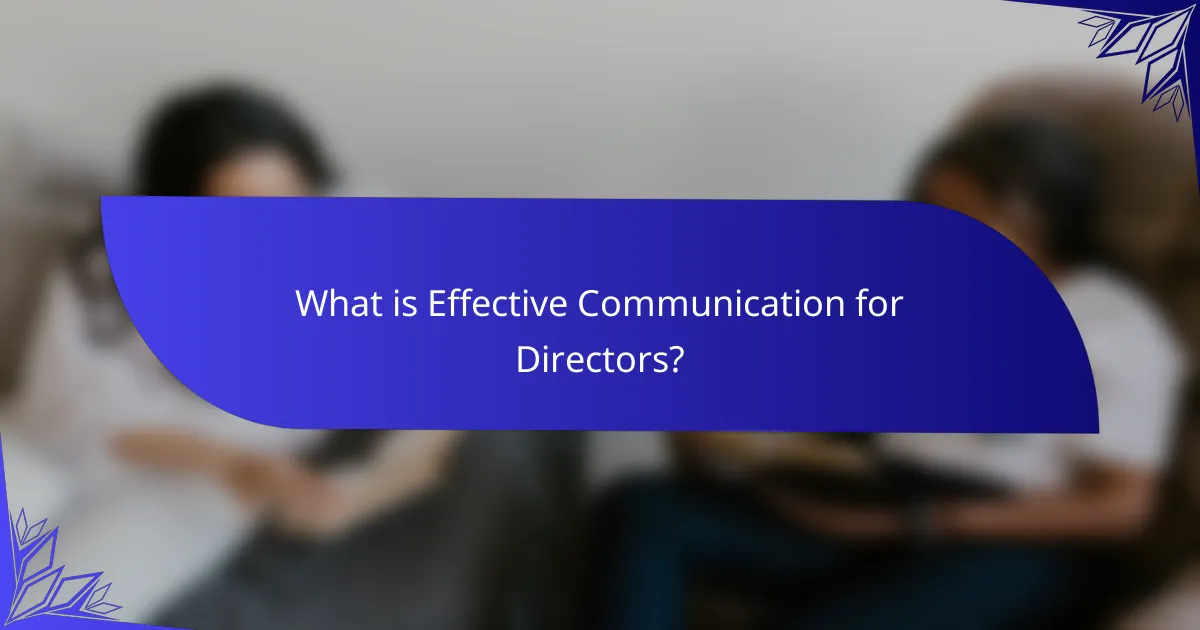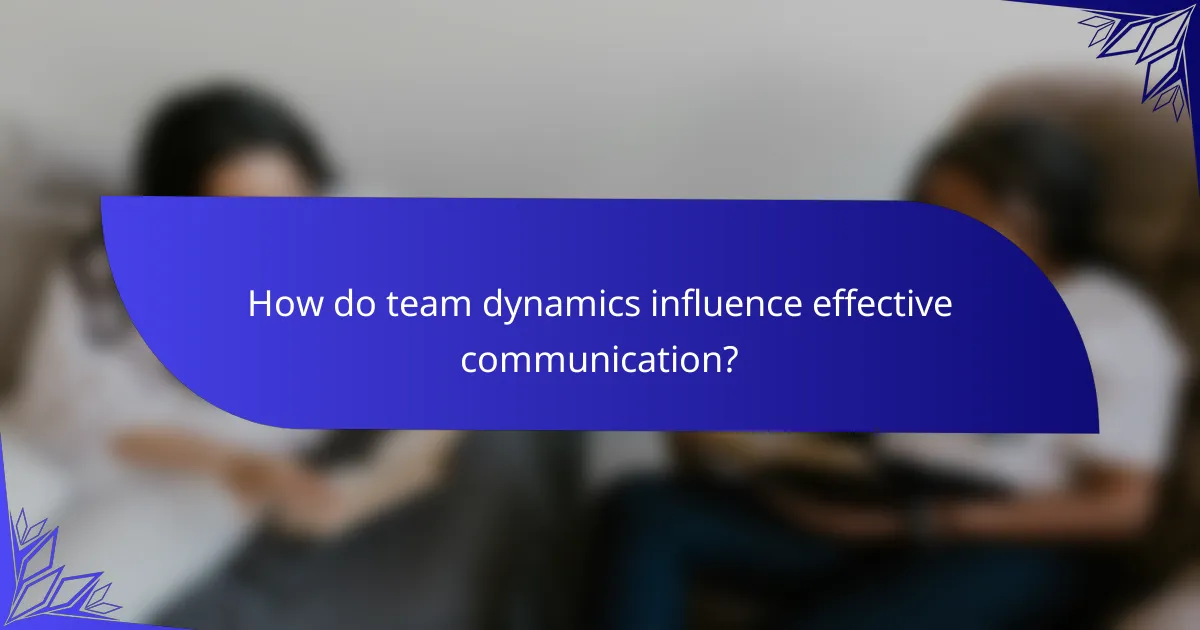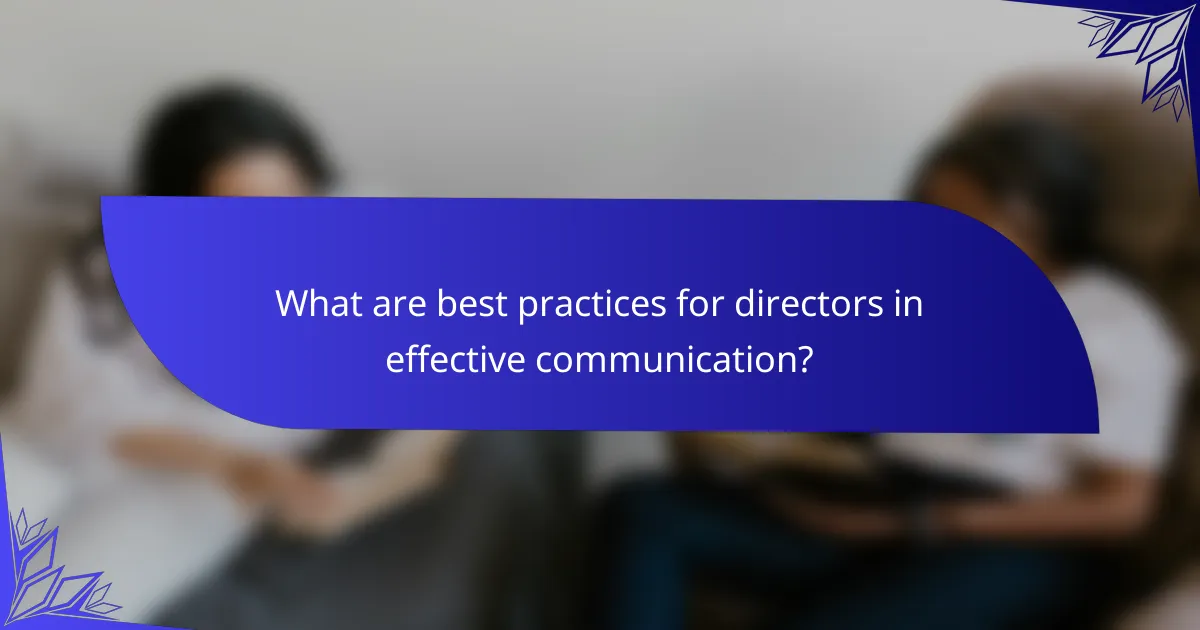Effective communication is crucial for directors, encompassing both verbal techniques and nonverbal cues, as well as the dynamics within teams. This article explores the importance of clear and persuasive communication in leadership, highlighting how directors can articulate their vision, actively listen to feedback, and foster collaboration. It emphasizes the role of team dynamics in enhancing communication effectiveness and discusses practices such as clarity, conciseness, and the alignment of verbal and nonverbal messages. Additionally, the article presents research findings that demonstrate the impact of effective communication on employee engagement, productivity, and overall team performance.

What is Effective Communication for Directors?
Effective communication for directors is the ability to convey information clearly and persuasively. This skill is essential for leading teams and making strategic decisions. Directors must articulate their vision and goals effectively. They should also listen actively to feedback from team members. Clear communication fosters collaboration and trust within an organization. Nonverbal cues, such as body language and tone, play a significant role in effective communication. Studies show that effective communicators are more successful in achieving their objectives. For example, companies with strong communication practices report higher employee engagement and productivity.
How does effective communication impact leadership?
Effective communication significantly enhances leadership effectiveness. It fosters clarity in conveying vision and goals. Leaders who communicate well can inspire and motivate their teams. This leads to increased employee engagement and productivity. Effective communication also helps in resolving conflicts swiftly. It builds trust and transparency within teams. According to a study by the Harvard Business Review, effective communication can improve team performance by up to 25%. Thus, leaders who prioritize communication create more cohesive and high-performing teams.
What are the key elements of effective communication?
Key elements of effective communication include clarity, active listening, empathy, and feedback. Clarity ensures that the message is easily understood. Active listening involves fully concentrating on the speaker, which fosters better understanding. Empathy allows communicators to connect emotionally, enhancing rapport. Feedback provides essential information on the effectiveness of the communication. These elements are supported by research indicating that effective communication improves team collaboration and productivity. For example, a study by the Harvard Business Review found that teams with high communication effectiveness are 25% more productive.
How can directors measure their communication effectiveness?
Directors can measure their communication effectiveness through feedback, assessments, and performance metrics. Gathering direct feedback from team members helps identify areas for improvement. Conducting surveys can quantify perceptions of clarity and engagement. Observing team dynamics during meetings provides insights into communication flow. Analyzing outcomes of projects linked to communication can reveal effectiveness. Regular performance reviews can highlight communication strengths and weaknesses. Utilizing tools like 360-degree feedback can offer comprehensive insights. These methods are supported by research indicating that effective communication correlates with team performance and satisfaction.
Why is verbal communication important for directors?
Verbal communication is crucial for directors as it facilitates clear and effective leadership. Directors must convey vision, goals, and strategies to their teams. Effective verbal communication fosters collaboration and alignment among team members. It enables directors to provide feedback and guidance efficiently. Additionally, strong verbal skills enhance relationships with stakeholders and clients. Research shows that effective communication improves team performance and morale. According to a study by the Project Management Institute, 56% of project success is attributed to effective communication. Therefore, verbal communication is essential for driving organizational success.
What verbal techniques can directors use to enhance their message?
Directors can use several verbal techniques to enhance their message. These techniques include clear articulation, active listening, and effective questioning. Clear articulation ensures that the message is understood without ambiguity. Active listening allows directors to engage with their audience and respond appropriately. Effective questioning stimulates discussion and encourages input from team members. Additionally, using storytelling can make messages more relatable and memorable. Incorporating feedback mechanisms helps directors gauge understanding and adjust their communication accordingly. These techniques collectively improve clarity and engagement in communication.
How do tone and clarity influence verbal communication?
Tone and clarity significantly influence verbal communication. Tone conveys emotions and attitudes, affecting how messages are received. A positive tone can enhance understanding and rapport. In contrast, a negative tone may lead to misunderstandings or conflict. Clarity ensures that the message is easily understood. Clear language reduces ambiguity and confusion. Research shows that effective communication improves team dynamics and productivity. According to a study by the International Journal of Business Communication, clear communication can increase employee engagement by 25%. Thus, both tone and clarity are essential for effective verbal communication.
What role do nonverbal cues play in communication for directors?
Nonverbal cues play a crucial role in communication for directors. These cues include body language, [censured] expressions, and gestures. Directors use nonverbal communication to convey confidence and authority. Effective nonverbal signals enhance message clarity and impact. Research shows that 93% of communication effectiveness is determined by nonverbal cues. Directors who master these cues can foster better team dynamics. They can build trust and rapport through appropriate nonverbal interactions. This ultimately leads to improved collaboration and productivity within their teams.
How can body language affect a director’s message?
Body language significantly affects a director’s message by conveying emotions and intentions without words. Nonverbal cues such as gestures, posture, and [censured] expressions enhance or contradict verbal communication. For instance, a confident stance can reinforce a director’s authority, while crossed arms may signal defensiveness or resistance. Research indicates that 55% of communication is nonverbal, highlighting its critical role. A study by Mehrabian (1971) emphasizes that body language can influence audience perception and engagement. Therefore, effective body language can strengthen a director’s message, ensuring clarity and impact.
What are common nonverbal cues to be aware of in leadership?
Common nonverbal cues in leadership include body language, eye contact, [censured] expressions, and posture. Body language conveys confidence or uncertainty. For instance, open arms suggest approachability, while crossed arms may indicate defensiveness. Eye contact demonstrates engagement and sincerity. Leaders who maintain eye contact are often perceived as trustworthy. [censured] expressions can communicate emotions such as enthusiasm or concern. A smile can create a positive atmosphere, while a frown may signal disapproval. Posture reflects authority and presence. Standing tall can inspire respect, whereas slouching may undermine a leader’s credibility. These cues significantly impact perceptions and interactions in leadership contexts.

How do team dynamics influence effective communication?
Team dynamics significantly influence effective communication. Positive team dynamics foster trust and openness among members. This environment encourages individuals to share ideas freely. Effective communication relies on active listening and mutual respect. When team members feel valued, they are more likely to engage in dialogue. Research shows that teams with strong dynamics achieve better collaboration. According to a study published in the Journal of Business Communication, effective communication improves team performance by 25%. Thus, healthy team dynamics enhance overall communication effectiveness.
What are the key factors in team dynamics that affect communication?
Key factors in team dynamics that affect communication include trust, conflict resolution, roles, and diversity. Trust facilitates open dialogue and encourages sharing of ideas. Effective conflict resolution prevents misunderstandings and promotes healthy discussions. Clearly defined roles ensure accountability and streamline communication. Diversity brings varied perspectives, enhancing problem-solving and creativity. Studies show that teams with high trust levels have 50% higher performance rates. Additionally, diverse teams are 35% more likely to outperform their peers.
How does trust within a team enhance communication?
Trust within a team enhances communication by fostering an open environment. In such an environment, team members feel safe to express their ideas and concerns. This safety encourages honest dialogue and reduces misunderstandings. When trust is present, feedback is received positively and constructively. Team members are more likely to share critical information without fear of negative repercussions. Research shows that effective communication improves team performance and collaboration. A study by Google highlighted that psychological safety, rooted in trust, is essential for effective team dynamics. Thus, trust directly contributes to better communication outcomes.
What impact does team diversity have on communication styles?
Team diversity significantly impacts communication styles within organizations. Diverse teams bring varied perspectives and experiences. This variation influences how members express ideas and interpret messages. For example, cultural backgrounds can shape preferences for direct or indirect communication. Research indicates that diverse teams often exhibit more creativity in problem-solving. A study by Page (2007) in “The Difference: How the Power of Diversity Creates Better Groups, Firms, Schools, and Societies” shows that diverse groups outperform homogenous ones in decision-making. Furthermore, team members may need to adapt their communication to ensure inclusivity. This adaptation can lead to enhanced collaboration and understanding. Ultimately, team diversity fosters a richer communication environment, promoting engagement and innovation.
How can directors foster effective communication within their teams?
Directors can foster effective communication within their teams by establishing clear channels for dialogue. They should encourage open discussions and actively solicit feedback from team members. Regular team meetings can provide structured opportunities for sharing ideas and addressing concerns. Directors must also model effective communication behaviors, such as active listening and providing constructive feedback. Utilizing collaborative tools and technology can enhance information sharing and keep everyone informed. Furthermore, creating a culture of trust and respect allows team members to feel comfortable expressing their thoughts. Research indicates that teams with strong communication practices are more productive and engaged. Effective communication can lead to improved team dynamics and overall success.
What strategies can be employed to improve team communication?
Implementing regular check-ins can improve team communication. These meetings provide opportunities for team members to share updates and address concerns. Establishing clear communication channels is essential. Teams should utilize tools like instant messaging and project management software. Encouraging open feedback fosters a culture of transparency. This approach allows team members to voice their opinions and suggestions. Setting clear expectations regarding communication norms is crucial. This ensures everyone understands their roles in the communication process. Additionally, promoting active listening enhances understanding among team members. Research shows that effective communication leads to improved team performance and morale.
How can feedback mechanisms enhance team dynamics?
Feedback mechanisms enhance team dynamics by promoting open communication and fostering trust among team members. They provide a structured way for individuals to express their thoughts and feelings. This encourages a culture of transparency, where everyone feels valued. Regular feedback helps identify strengths and areas for improvement. It also aligns team goals and expectations, ensuring everyone is on the same page. According to a study by the Institute for Corporate Productivity, organizations with effective feedback systems see a 14.9% increase in employee engagement. Enhanced engagement leads to higher productivity and better collaboration within teams.

What are best practices for directors in effective communication?
Directors should prioritize clarity and conciseness in communication. Clear messages reduce misunderstandings. Concise language respects time and enhances engagement. Active listening is crucial for effective dialogue. It encourages feedback and shows respect for others’ opinions. Nonverbal cues should align with verbal messages. Consistency between words and body language builds trust. Regular updates keep teams informed and aligned. Transparency fosters an open communication culture. Utilizing appropriate communication tools enhances message delivery. Tailoring communication style to the audience improves receptiveness. These practices lead to more effective leadership and team dynamics.
How can directors improve their verbal communication skills?
Directors can improve their verbal communication skills by practicing active listening. Active listening enhances understanding and fosters better responses. They should also engage in public speaking training to build confidence. Regular feedback from peers can identify areas for improvement. Using clear and concise language minimizes misunderstandings. Directors can also participate in workshops focused on communication techniques. Role-playing scenarios can help simulate real-life situations. Finally, studying effective communicators provides insights into successful strategies.
What practical exercises can enhance verbal communication?
Practicing active listening can enhance verbal communication. This exercise involves fully concentrating on the speaker. It helps in understanding their message better. Role-playing different scenarios can also be effective. This method allows individuals to practice responses in a controlled environment. Engaging in public speaking drills is beneficial too. These drills improve confidence and articulation. Participating in group discussions fosters the exchange of ideas. This encourages clarity and coherence in communication. Recording and reviewing conversations can provide insights. Individuals can identify areas for improvement. Regular feedback from peers enhances verbal skills further. This creates opportunities for continuous growth.
How can directors handle difficult conversations effectively?
Directors can handle difficult conversations effectively by preparing in advance. They should identify the key points to address. Practicing active listening is crucial during the discussion. This ensures that all parties feel heard and valued. Maintaining a calm and composed demeanor helps to set a positive tone. Using clear and concise language avoids misunderstandings. It is also important to focus on solutions rather than problems. Following up after the conversation reinforces commitment to resolving issues. These strategies enhance communication and foster a constructive environment.
What tips can enhance nonverbal communication for directors?
Directors can enhance nonverbal communication by mastering body language. Maintaining eye contact conveys confidence and engagement. Open body posture promotes approachability and trust. Using purposeful gestures emphasizes key points and aids retention. [censured] expressions should align with verbal messages to reinforce sincerity. Active listening is crucial; nodding and leaning slightly forward show attentiveness. Personal space awareness helps maintain comfort in interactions. Practicing these techniques can lead to improved team dynamics and clearer communication.
How can directors become more aware of their body language?
Directors can become more aware of their body language through observation and practice. They should regularly observe their own gestures and posture during interactions. Recording and reviewing their presentations can provide insights into their nonverbal cues. Seeking feedback from colleagues or mentors can highlight areas for improvement. Directors can also engage in workshops focused on body language. Understanding the impact of body language on communication is crucial. Research indicates that nonverbal signals can account for up to 93% of communication effectiveness. By consciously adjusting their body language, directors can enhance their communication skills.
What techniques can improve nonverbal cues in presentations?
To improve nonverbal cues in presentations, directors can utilize several techniques. Firstly, maintaining eye contact with the audience fosters engagement and trust. Secondly, using purposeful gestures enhances message delivery and emphasizes key points. Thirdly, adopting an open posture conveys confidence and approachability. Fourthly, varying vocal tone and pace can underscore important information and maintain interest. Additionally, being aware of [censured] expressions ensures they align with the message being communicated. Practicing in front of a mirror or recording oneself can help identify and refine nonverbal behaviors. Research indicates that effective nonverbal communication can significantly enhance audience perception and retention of information.
How can directors apply communication strategies to improve team dynamics?
Directors can apply communication strategies to improve team dynamics by fostering open dialogue among team members. They should encourage feedback during meetings to create a collaborative environment. Active listening is essential; it helps to validate team members’ ideas and concerns. Additionally, directors can utilize clear and concise messaging to ensure everyone understands their roles and objectives. Nonverbal communication, such as maintaining eye contact and positive body language, can enhance trust within the team. Regular team-building activities can also strengthen relationships and improve overall communication. Research indicates that effective communication leads to higher employee satisfaction and productivity, reinforcing the importance of these strategies.
What are the benefits of regular team check-ins for communication?
Regular team check-ins enhance communication by fostering transparency and collaboration. They provide a structured opportunity for team members to share updates and address concerns. This regularity helps build trust among team members. It also allows for real-time feedback, which can improve project outcomes. According to a study by Gallup, teams that engage in regular check-ins have 25% higher productivity. Additionally, these meetings encourage accountability, as team members are more likely to follow through on commitments. Overall, regular check-ins create a more cohesive and engaged team environment.
How can directors create an open communication culture?
Directors can create an open communication culture by fostering an environment of trust and transparency. They should encourage feedback from all team members to ensure everyone feels heard. Regular meetings can provide a platform for sharing ideas and concerns. Directors must model open communication by being approachable and responsive. They should also implement tools that facilitate communication, such as collaborative platforms. Training sessions on effective communication can enhance skills across the team. Research shows that organizations with open communication see improved employee engagement and productivity.
Effective communication for directors is the ability to convey information clearly and persuasively, essential for leadership and strategic decision-making. This article explores the importance of verbal and nonverbal communication techniques, highlighting key elements such as clarity, active listening, and empathy. It also examines how team dynamics, trust, and diversity influence communication effectiveness. Furthermore, the article provides strategies for directors to enhance their communication skills and foster an open communication culture within their teams, ultimately leading to improved collaboration and productivity.